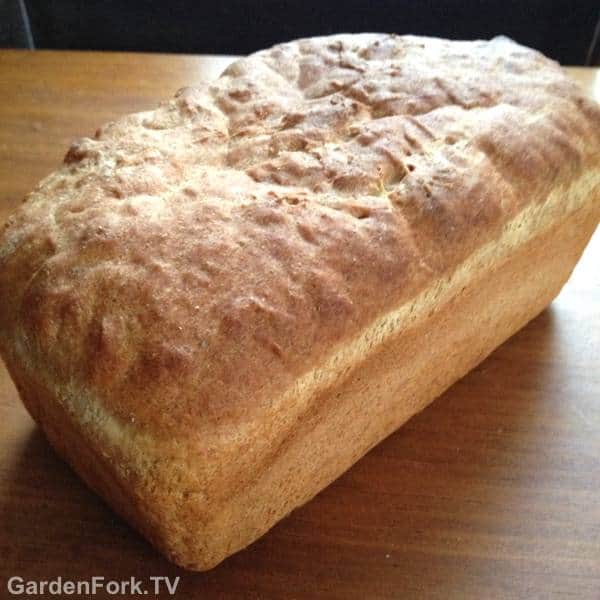Here’s my Troy Bilt Flex review after using the Flex Power Base and the Wide Area Mower and Pressure Washer around the GardenFork Testing Grounds. The testing grounds, otherwise known as my yard, are typical of what your average homeowner has: grass, trees, some weeds, dogs.

Full Disclosure: Troy Bilt has compensated me for my time and provided me with their products. Opinions are mine own, and I don’t work with companies that aren’t a good fit for me or the GardenFork audience. More info here.
I’ve known the Troy-Bilt brand for many years. Their rear tine rototillers are the best, I think, and make life easy, especially if you’ve ever wrestled with a front tine tiller.
So when I was asked if I’d like to try out Troy Bilt’s new Flex system, I signed on. The delivery truck brought 3 boxes of Flex components, and I got 4 free wood pallets from the truck driver. Neat.

The Troy-Bilt Flex Review
Here’s the way I describe the Flex system: Its all based on a power unit that a bunch of different tools snap onto. The Flex base is like the rear half of a walk behind self propelled snowblower with a PTO out the front that snaps into several different attachments. I like the idea of having one power source and a bunch of outdoor equipment attachments. So I only have to maintain one engine, not an engine for every outdoor power tool in the garage. Plus, you save on garage storage space – the attachments have a smaller footprint – making it all easier to store.

If you’ve ever been on a working farm, all the tractors have a PTO (power take off) shaft on the back and sometimes front to run different machines, this is the same concept for the Flex line.
Right now Troy-Bilt has mower, snow thrower, pressure washer, and leaf blower attachments for the power base, I’m told a log splitter and a few other attachments are in the works. I’d really like that log splitter, it would make fast work of the pines I’ve been dropping for next winter’s sap season.
I chose the Wide Area Mower and the Pressure Washer attachments to test out. The back of my clapboard house has mold growing on it, so this was perfect. We’ll be making a video showing the power washing and mowing this summer.
First I snapped on the mower deck.

What I like about the Troy-Bilt Flex Wide Area Mower:
It feels solid. This is kinda intangible, I know, but you know how some mowers just feel cheap? This doesn’t, it has good feel and nice power.
The power wheels are better, they are pnuematic, meaning they have air in them instead of solid plastic wheels of many self-propelled walk behinds. The rig powers nicely through the lawn. The drive system is robust, unlike many self-propelled mowers that have a small belt that powers the wheels.
The mower deck is 28″ wide, so I’m already saving time from my 20″ wide walk behind mower. Rough math tells me that every 3 passes with the Flex is 4 passes with my smaller mower.
The front wheels spin free, so you can make surprisingly tight turns for such a large mower deck. You can also lock the wheels for when you are mowing on hills for better control.

The Flex powers through the yard at a nice clip with enough power to go up a moderate hill. The lever that controls the speed of the wheels takes a few minutes to master, the low end of the range is short, so when you grab the lever, it starts moving faster than you expect at first. You should wear ear protection, the Flex mower isn’t super loud, but it all adds up.
For additonal info on the Flex mower and more, check out their website here.

I then worked with the Pressure Washer attachment. Here’s where the advantages of the Flex system become clear. I don’t have to own a pressure washer that has its own engine, this pressure washer just snaps onto the Flex base. One less engine to maintain.

The pressure washer comes with 5 spray nozzles and 40′ of hose, plenty to get up to the 2nd floor of your house and wash the siding. It pumps 3,000 psi, which is more than enough for what you all are doing around the house. I used a friend’s power washer a while back and it was made mostly of plastic, this isn’t. Plus I like the hose rack, its large enough to store all of the hose, unlike some other washers I’ve used where the hose storage never works.
I know GardenFork is all about ‘done is better than perfect’, but sometimes the details matter, and the photo below makes that clear to me. When I put gas in the Flex tank, I saw the cap was chained, and the chain was metal, not plastic. It’s not something many would notice, but that tells me the people who designed this designed it to last.

I’ll be doing a Troy Bilt Flex Review video this summer, where we power wash one of the plywood boats, wash the back of the house, and power through my lawn in 2/3 the time it takes with the smaller mower I own.
UPDATE: here’s the video review of the FLEX:
To read more about the Troy Bilt Flex and other outdoor power equipment, here is their website, plus:
Rochelle of Pith + Vigor reviewed Troy-Bilt’s new Bronco Axis Vertical Tine tiller, which I tested out, and its a nice one.
Kenny of Veggie Gardening Tips also wrote a Troy Bilt Flex review here.
Erin of The Impatient Gardener wrote about the Troy Bilt XP Horse Lawn Tractor. Note the cup holder. nice.
Kim of Sand and Sisal reviewed the Troy Bilt 4 cycle trimmer that has a ton of attachments. I got to use this gear when we went to meet Troy Bilt, and its a nice set of tools.












 See More Pizza Oven Assembly Photos Here
See More Pizza Oven Assembly Photos Here
























































